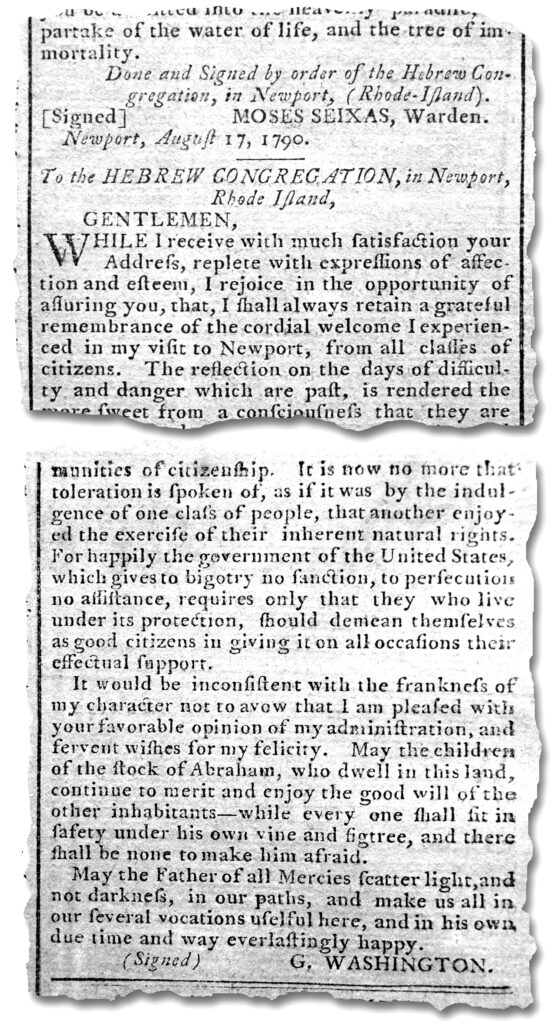Deciding which newspapers to offer – Bond Hall Explosion edition…
July 26, 2024 by GuyHeilenman · Leave a Comment  Email This Post
|
Email This Post
|  Print This Post
Print This Post
We are often asked how we decide which newspapers from our archives to collect and/or offer to other collectors. The answer is quite involved. Is it rare, and if so, is it desirable? Is it historic? A large portion of collectible issues relate to the plethora of events we all learned about in grade school. Does it tell of a sports or political milestone… a broken record… a tragedy… a discovery… an invention? Does it have content related to another collectible (ex., model train enthusiasts love to add newspapers featuring coverage of the development of the railroad). If the answer to any of these questions (and similar) is yes, chances are the newspaper will have value to a collector of historic newspapers. Requests from collectors are also a great way to discover new issues to offer, as are movie releases, current events which relate to the past, and new books (both non- and historical fiction).
One of my favorite “reasons” for exploring our archives in the hopes of finding something new to collect and/or to offer to others is the latter: historical fiction. I think part of the fun for me is discovering whether or not a particular event I read about is more “historical” or more “fiction”.
This trek was recently inspired when I became aware of author Michelle Collins Anderson’s new novel, “The Flower Sisters”.
A review by journalist James Gardener included in part: ““The Flower Sisters” is a must-read for anyone interested in the intersection of history, memory, and storytelling. Join Daisy Flowers on her quest for truth and justice”.
The outcome? The photo below from an issue of the Kansas City Journal for April 15, 1928 reveals what I surmised by a brief internet search. How horrible. Unfortunately, the cause still remains a mystery.
Note: What’s a Zizzer? A town can often be defined by a single sensational event – be it tragic (in this instance), historical (Williamsburg, VA), spectacular (Aspen, Colorado), etc. It is easy to forget that these locations have much more to explore than these single moments in time. While the Bond Dance Hall was truly horrific, there is no doubt those who have lived there over time see much more. Feel free to learn more about West Plains, Missouri at: West Plains. Perhaps “Zizzer” will become part of your vocabulary. Randon thought: I wonder if Dick Van Dyke ever had a local Zizzer?
If you liked this post, you may also enjoy...
- Digital newspaper archives…
- Pricing newspapers over 30 years ago…
- Collecting Rare & Early Newspapers… on a budget…
- Prices of newspapers… How have the changed?
- Countdown to “Newspapers that changed the world…”
Since History Often Repeats Itself, the Past Can be an Excellent Teacher…
July 22, 2024 by Laura Heilenman · Leave a Comment  Email This Post
|
Email This Post
|  Print This Post
Print This Post
Why does the saying, “Those who cannot remember the past are condemned to repeat it”, ring true? Perhaps it’s because of another saying, “History repeats itself”. We see this tandem of truths play out over-and-over again as we look through historic newspapers and see the headlines of today emblazed on the old worn pages of yesteryear. Below is a vivid example of this truth as shown in a FRANK LESLIE’S ILLUSTRATED, New York, Oct. 10, 1885. When compared side by side with a BBC article from 130+ years later, we can see the waves of history crash on the beach of time in the same way and with a similar impact on humanity. If we hope to see the storms of the future coming in time to make ready, perhaps we should study the past a bit more closely.

If you liked this post, you may also enjoy...
- Innocence… Flag Day 1921
- A look back at the past’s look into the future…
- Never say never…
- What did they do to false prophets? 1929 predicted to be a banner financial year…
- My collecting story… T. S. P. in New York, NY…
The July (2024) Newsletter from Timothy Hughes Rare & Early Newspapers…
July 19, 2024 by GuyHeilenman · Leave a Comment  Email This Post
|
Email This Post
|  Print This Post
Print This Post
|
|
If you liked this post, you may also enjoy...
- The May (2019) Newsletter from Rare & Early Newspapers…
- The October (2019) Newsletter from Rare & Early Newspapers…
- The March (2018) Newsletter from Rare & Early Newspapers…
- March, 2024 Newsletter from Timothy Hughes Rare & Early Newspapers…
- The October (2017) Newsletter from Rare & Early Newspapers…
Don’t try this at home. . . or ANYWHERE for that matter!
July 15, 2024 by Laura Heilenman · Leave a Comment  Email This Post
|
Email This Post
|  Print This Post
Print This Post
 We have all heard various versions of, “Kids, Don’t try this at home!”, including in 1966 when Batman and Robin (Adam West and Burt Ward) told us, “Remember kids, Batman can’t fly.”
We have all heard various versions of, “Kids, Don’t try this at home!”, including in 1966 when Batman and Robin (Adam West and Burt Ward) told us, “Remember kids, Batman can’t fly.”
Perhaps Ben Franklin should have penned “Don’t try this at home. . . or anywhere” shortly after he successfully completed his famous lightning/kite experiment. If he had thought this through, we may never have had his follow-up letter describing copycat deaths printed in…
THE AMERICAN MUSEUM OR UNIVERSAL MAGAZINE, September 1790.
Thankfully he survived his own efforts in 1752.
So, just in case you missed the memo, remember kids, Batman can’t fly… or catch lightning, and neither can you!
If you liked this post, you may also enjoy...
- Most historic: The Declaration of Independence in your collection…
- Ben Franklin – a Man of Endless Talents…
- Print date for the Gentleman’s Magazine…
- The Traveler… first female aviator killed… turn-about is fair play…
- Publius Lentulus’ 1st century description of Jesus Christ…
The Founding Documents – the Bill of Rights edition…
July 12, 2024 by Laura Heilenman · Leave a Comment  Email This Post
|
Email This Post
|  Print This Post
Print This Post
I recently read about a “man on the street survey” where people were asked to choose one of the rights enumerated in the Bill of Rights from a list of 4 options. The options were: The right to vote, the right to healthcare, the right to a public education and the right to trial by a jury of your peers. Sadly, most of those interviewed did not pick the correct one. Even worse, most picked either the right to healthcare or the right to a public education. I quickly sent a group text to my adult children and asked them the same question and then awaited their responses with a bit of trepidation. Thankfully, my concern was unfounded.
One of the reasons we at RareNewspapers.com love what we do is that we feel as if we are helping to keep the heart of our country alive by protecting authentic papers containing real-time (contemporary) reports regarding our founding documents such as the Bill of Rights. The portion shown below was printed in THE PENNSYLVANIA PACKET & DAILY ADVERTISER, Philadelphia (PA), October 6, 1789. Newspapers like these need to be cherished and their message intentionally disseminated to all generations so future surveys are a bit more encouraging. Thanks in advance.
If you liked this post, you may also enjoy...
- Equal rights – a long and arduous path…
- Veterans – War’s end is rarely met with the end to their battles…
- Snapshot 1801… The importance of newspapers…
- The Traveler… the wanderer…
- True? Muhammad’s pledge of protection for Christians…
This Month in History – July…
July 8, 2024 by GuyHeilenman · Leave a Comment  Email This Post
|
Email This Post
|  Print This Post
Print This Post
July was a busy month from a (an) historic perspective. While it has always been a “time for war”, some of the most amazing discoveries, accomplishments, and human advancements have also made their way onto the historic July Calander. While the list is almost endless, three-handfuls include:
- A French soldier discovers the Rosetta Stone (July 19, 1799)
- First photographs were used in a newspaper (July 1, 1848)
- U.S. Congress authorizes the Medal of Honor (July 12, 1862)
- P.T. Barnum’s Museum burns down (July 13, 1865)
- Philadelphia Zoo opens, the first zoo in the U.S. (July 1, 1874)
- President Garfield is shot (July 2, 1881)
- Louis Pasteur successfully gives first anti-rabies vaccination to nine-year-old (July 6, 1885)
- The 16th Amendment, the power to tax income, is passed by Congress (July 12, 1909)
- Albert Einstein introduces his Theory of Relativity (July 1, 1905)
- “Lady Astor’s Bill” passes lowering UK drinking age to 18 (July 13, 1923)
- The bikini is showcased for the first time (July 5, 1946)
- Walt Disney’s Disneyland opens in Anaheim, CA (July 17, 1955)
- The first moon walk takes place (July 20, 1969)
- Hank Aaron hits his 755th and last home run (July 20, 1976)
- First ‘Test Tube Baby’ is born (July 25, 1978)
For those who have interest in exploring the available newspapers at RareNewspapers.com which may contain reports on some of the above, along with a host of other newsworthy articles, a link to the chronological list is shown below. We hope you enjoy your trek.
NEWSPAPERS PUBLISHED IN JULY
If you liked this post, you may also enjoy...
- The Traveler… “Who’s the leader of the club…?”
- Love of History Takes Many Forms…
- This Month in History – March…
- This Month in History – June…
- Calendar Section of the Los Angeles Times … Mini-Time Capsules of Our Lives…
Sometimes you just know what it means – The Spirit of ’76…
July 4, 2024 by Laura Heilenman · 1 Comment  Email This Post
|
Email This Post
|  Print This Post
Print This Post
 Sometimes you hear a word or a phrase and even though you can’t clearly give a written definition, you just have a gut feeling of what it means. Earlier today, when I was looking at a Picture and Magazine section from a Chicago Sunday Tribune, July 4, 1926, I breezed by the caption of the front-page image… The Spirit of ’76. After a moment, I found my mind wasn’t so much thinking of what that phrase meant, but instead, I was struck by the emotions which had been stirred… pride (in a good way as my mother would say), determination & a deep sense of purpose. Wanting to see if the phrase, “The Spirit of ’76” had a clear definition, I went to Wikipedia and found the following…
Sometimes you hear a word or a phrase and even though you can’t clearly give a written definition, you just have a gut feeling of what it means. Earlier today, when I was looking at a Picture and Magazine section from a Chicago Sunday Tribune, July 4, 1926, I breezed by the caption of the front-page image… The Spirit of ’76. After a moment, I found my mind wasn’t so much thinking of what that phrase meant, but instead, I was struck by the emotions which had been stirred… pride (in a good way as my mother would say), determination & a deep sense of purpose. Wanting to see if the phrase, “The Spirit of ’76” had a clear definition, I went to Wikipedia and found the following…
“The Spirit of ’76 is a sentiment explored by Thomas Jefferson. According to the text published at Monticello, “The principles outlined in the Declaration of Independence promised to lead America—and other nations on the globe—into a new era of freedom. The revolution begun by Americans on July 4, 1776, would never end. It would inspire all peoples living under the burden of oppression and ignorance to open their eyes to the rights of mankind, to overturn the power of tyrants, and to declare the triumph of equality over inequality.”
Thomas Jewett wrote that at the time of the American Revolution, there was “an intangible something that is known as the ‘Spirit of ’76.’ This spirit was personified by the beliefs and actions of that almost mythical group known as the Founding Fathers and is perhaps best exemplified by Thomas Jefferson.”
Jefferson and the Second Continental Congress believed the Spirit of ’76 “included the ‘self-evident’ truths of being ‘created equal’ and being ‘endowed by their Creator with certain inalienable rights’ including ‘life, liberty, and the pursuit of happiness.'” ~ Wiki
Hmmmm… “an intangible something”. I would agree this spirit is hard to completely capture with words, but it can certainly be understood with a feeling, a picture, or a flag, and it is certainly a “spirit” we need in abundance today.
If you liked this post, you may also enjoy...
- The Traveler… must have been a slow news day…
- Capturing the Vibe… Christmas 1903…
- “A Picture Paints a Thousand Words” rings true in the world of newspaper collecting…
- Additional kudos for, “Reporting the Revolutionary War”…
- Believe it or not…
The revered September 15, 1790 issue of the Gazette of the United States. The back story…
July 1, 2024 by TimHughes · Leave a Comment  Email This Post
|
Email This Post
|  Print This Post
Print This Post
We are very proud to offer the most significant American newspaper with Jewish content, in which Washington assured the congregation of the Touro Synagogue in Newport, Rhode Island, that the United States “…gives to bigotry no sanction, to persecution no assistance…”, perhaps the more famous utterance by a President in the establishment of religious freedom.
The newspaper is the “Gazette Of The United States” dated September 15, 1790, published in New York at the time. To fully appreciate its significance, we offer the following “back story” to this issue containing both Seixas’ letter of welcome to Washington,
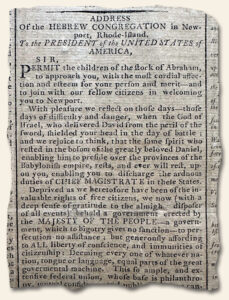
and Washington’s response to the congregation of the Touro Synagogue.
Upon his election as President, many churches, congregations, and religious societies wrote to George Washington to congratulate him on his new office, and he replied to each of them with personalized messages of thanks for their well-wishes. In his reply to the Hebrew Congregation of Newport, Washington applauded the people of the United States for rejecting the European practice of religious “toleration,” embracing instead the “large and liberal policy” that religious liberty is a natural right — and not a gift of government — which all citizens are equally free to exercise.
In 1790, George Washington visited Rhode Island to acknowledge the state’s recent ratification of the Constitution and to promote passage of the Bill of Rights, the first ten amendments to the Constitution. As was the custom, when Washington visited Newport, he was met by a delegation of citizens, who read messages of welcome. One of those who welcomed Washington was Moses Seixas, the warden of the Touro Synagogue in Newport. Touro is the oldest synagogue building in America and the only one existing from the colonial era. In his welcome, Seixas gave thanks to “the Ancient of Days, the great preserver of men” that the Jews, previously “deprived … of the invaluable rights of free Citizens” on account of their religion, now lived under a government “which to bigotry gives no sanction, to persecution no assistance.”
Washington was moved by Seixas’ letter. The president’s response differentiated between religious toleration and religious liberty, as it specifically applied to American Jews. Washington wrote that Americans “have a right to applaud themselves for having given to mankind examples of an enlarged and liberal policy – a policy worthy of imitation . . . It is now no more that toleration is spoken of as if it were the indulgence of one class of people that another enjoyed the exercise of their inherent natural rights.”
Washington’s reply set a significant precedent that separated a more passive practice of tolerance, from the more potent one of liberty. Even the most liberal European states such as the Netherlands had policies that merely tolerated non-Protestants. In alluding to the Bible’s Old Testament, Washington unequivocally called for religious equality for Jews stating that “the Children of the Stock of Abraham . . . shall sit in safety under his own vine and fig tree.”
Notably, Washington imitated Seixas’s phrasing in his reply in writing that the United States “gives to bigotry no sanction, to persecution no assistance” requiring only that they who live under its protection should demean themselves as good citizens, in giving it on all occasions their effectual support.” The president’s reply made loyalty to country, as opposed to Protestant allegiance, the prerequisite for religious equality.
This letter was written during Washington’s first term as President and is Washington’s clearest statement of religious tolerance. It is considered a steppingstone for the First Amendment that would come the following year in 1791 and is considered a foundational document establishing Washington’s belief in the separation of church and state.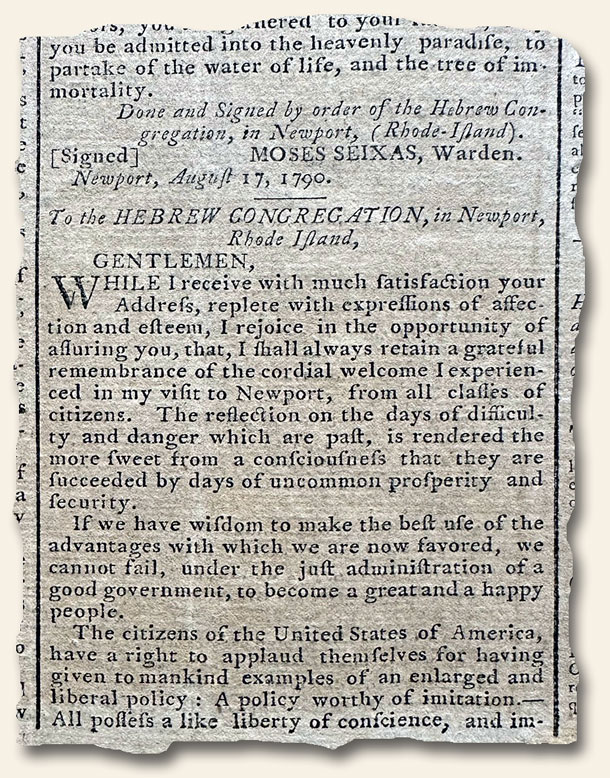
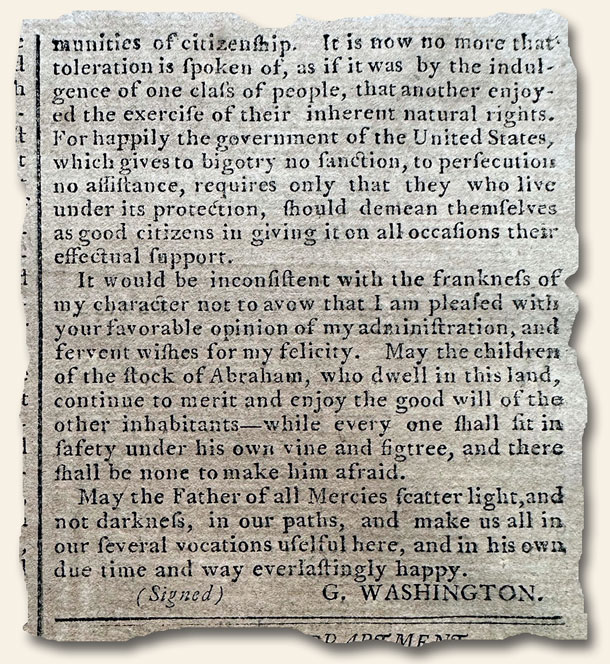
If you liked this post, you may also enjoy...
- The Traveler… Rabbi Gershom Seixas… 1st native-born American rabbi…
- Rare Judaica Collectibles Spanning Three Centuries – 1600’s, 1700’s, & 1800’s…
- George Washington and the Hebrew Congregation in Savannah… 1790…
- Mark Twain… on the Jews…
- Equal rights – a long and arduous path…
Announcing: Catalog #344 for July, 2024 – Rare & Early Newspapers…
June 28, 2024 by GuyHeilenman · Leave a Comment  Email This Post
|
Email This Post
|  Print This Post
Print This Post
|
|
[The links above will redirect to the latest catalog in approx. 30 days
upon which time it will update to the most recent catalog.]
If you liked this post, you may also enjoy...
- Announcing: Catalog #332 for July, 2023 – Rare & Early Newspapers…
- Announcing: Catalog #343 for June, 2024 – Rare & Early Newspapers…
- Announcing: Catalog #342 for May, 2024 – Rare & Early Newspapers…
- Announcing: Catalog #335 for October, 2023 – Rare & Early Newspapers…
- Announcing: Catalog #341 for April, 2024 – Rare & Early Newspapers…
The Power of Music… Classics Never go out of Style!
June 24, 2024 by LauraH · Leave a Comment  Email This Post
|
Email This Post
|  Print This Post
Print This Post
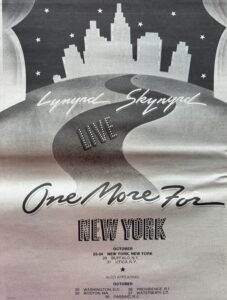 Has anyone else noticed how music from the 60’s-90’s has made a huge cultural comeback? From movies to commercials… from concerts to radio, the oldies but goodies are being sung (or at least hummed) by everyone from Boomers to Gen Zers. Music not only soothes the savage beast, it also brings whimsy to a warm summer day and sets the mood for a cozy winter evening. So, it is not surprising that collectors LOVE the concert ads in THE VILLAGE VOICE out of Greenwich Village, NY. Interests range from Bob Dylan, Kiss and The Grateful Dead to Lynyrd Skynyrd and Tiny Tim (with his famous ukulele). This retro music can whisk us away to a memory tucked in the back of our minds and flood us with all the emotions we felt as our younger selves. Almost daily, as I prep these concert ads for our collectors, I am transported to a music memory from long ago and reminded again that newspaper collecting has a sweet spot for everyone.
Has anyone else noticed how music from the 60’s-90’s has made a huge cultural comeback? From movies to commercials… from concerts to radio, the oldies but goodies are being sung (or at least hummed) by everyone from Boomers to Gen Zers. Music not only soothes the savage beast, it also brings whimsy to a warm summer day and sets the mood for a cozy winter evening. So, it is not surprising that collectors LOVE the concert ads in THE VILLAGE VOICE out of Greenwich Village, NY. Interests range from Bob Dylan, Kiss and The Grateful Dead to Lynyrd Skynyrd and Tiny Tim (with his famous ukulele). This retro music can whisk us away to a memory tucked in the back of our minds and flood us with all the emotions we felt as our younger selves. Almost daily, as I prep these concert ads for our collectors, I am transported to a music memory from long ago and reminded again that newspaper collecting has a sweet spot for everyone.
If you liked this post, you may also enjoy...
- Were you there – 1974? Bob Dylan returns from a nearly 8-year absence…
- The Village Voice… The Heart of the 60’s-70’s Anti-Establishment Youth Culture…
- Were you there – 1981? The Kinks perform at Madison Square Garden…
- The Village Voice… Greenwich Village, New York…
- The plight of newspapers & its impact on the hobby…







